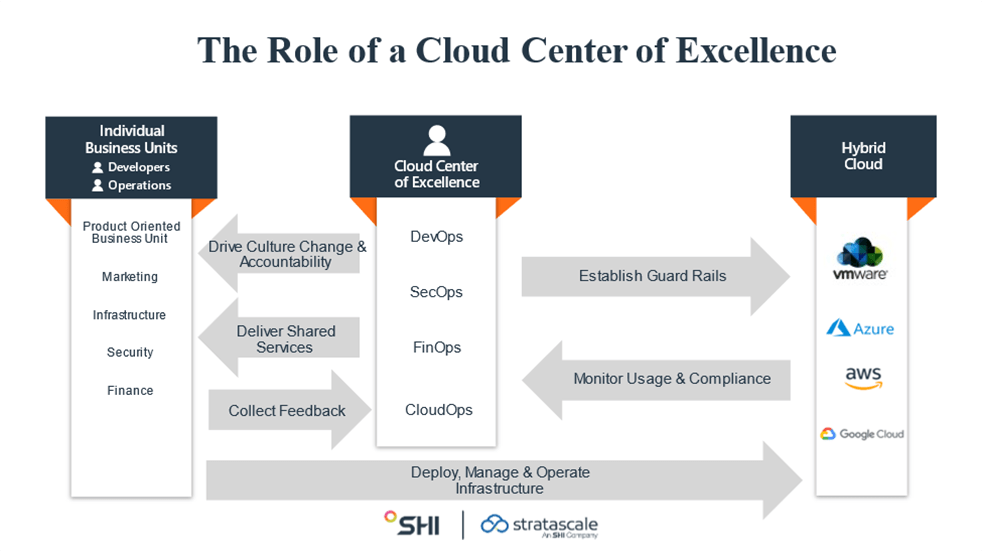What is a Cloud Center of Excellence and why would you establish this practice?:
Assess your current cloud maturity, organizational alignment, and strategy

The public cloud has disrupted entire industries. Organizations continue to move infrastructure and applications to the public cloud to accelerate innovation and digital transformation. However, adopting a new cloud operating model can be a major organizational shift. Establishing a Cloud Center of Excellence (CCoE) is a proven best practice for enabling speed and agility as your organization adopts cloud technologies.
What is a Cloud Center of Excellence?
A CCoE is responsible for defining common infrastructure practices, enforcing policy across teams, maintaining shared services, breaking down silos, and helping with new financial models. It comprises two cross-functional teams – a cloud engineering team and a cloud steering committee.
The cloud engineering team is tasked with being the stewards of the cloud and guiding how the organization consumes the cloud. In addition, they are the technical delegates that ensure the organization exploits the cloud potential. The cloud steering committee is responsible for developing and managing the cloud strategy, governance, and best practices that the rest of the organization can leverage to transform the business using the cloud.
As you transform and adopt cloud technologies, it’s common to face adoption hurdles, including controlling cloud spend, maintaining security and compliance, finding and retaining experienced talent, and codifying your environment. Leadership can also make a significant impact on adoption; without a top-down support approach across executives, it will be costly and not meet business expectations.
From navigating the learning curve of new architectures to avoiding IT burnout, an established CCoE can help address these challenges and accelerate the adoption of public and hybrid cloud technologies.
Transformation requires modernization
Many organizations and the modern workplace centers now operate in a hybrid world utilizing on-premises models in addition to the cloud. A hybrid model is a must, as most businesses don’t have the luxury to forgo their technical debt and leave on-premises behind altogether. While we see two models in principle – a cloud operating model and a traditional IT operating model – it’s not reality.
As most organizations work in and support both models, it’s not as clearly defined when it comes to the actual world. The most common strategy we see, and one that SHI educates customers on, is to adopt to and utilize cloud when it makes sense. This approach can apply to new initiatives that meet the following requirements but are not limited to:
- Workloads:
- Including seasonal, cloud-native, or global distributed workloads, or workloads that can contract and expand on demand
- High-performance compute workloads or analytics where utilization is not persistent 24/7
- IoT/data streaming or mobile app/device backend that are beyond regional boundaries
- Edge solution support
- Web/content hosting
- AI/cognitive/machine learning
- Backup/disaster recovery (limited use cases)
- Batch processing
- CRM, data management, and governance
- Multi-tenant based – SaaS applications
- Non-IaaS infrastructure
Digital transformation brings a holistic approach and promotes essential changes for growth, which are required when transitioning from traditional IT operating models to cloud operating models. From a financial perspective, many organizations struggle with new billing models, fluctuating costs, and the inability to accurately predict and control spending. Most are often still very capex friendly and pivoting to an opex model proves challenging.
How does a CCoE address these hurdles?
A cloud engineering team helps organizations address the technical challenges and guide the other specialized teams, while a cloud steering committee – led by senior leaders – helps drive the organization’s culture as you begin this metamorphosis. Culture is driven from the top down, and without priority alignment to utilize the cloud across core teams, including security, product, finance, and IT, it simply fails. The culture of an organization must change with this evolution because all parts of your business are generally impacted, either directly or indirectly.
Typically, organizations start small and later scale in the cloud, and so should your CCoE. Establishing a cloud engineering team is the starting point, then adding a cloud steering committee and growing your CCoE as it makes sense.
SHI offers executive briefings and free workshops, providing support from a cloud engineering and services perspective. Our experts can help you define your CCoE program goals, whether you are looking to:
- Build a modern IT organization through agile approaches.
- Use deployment packages that align with security, compliance, and service management policies.
- Preserve functional cloud platform in alignment with operational procedures.
- Review and approve the use of cloud-native tools.
- Standardize and automate commonly needed components and solutions to save on time and resource management.
No matter where you are in your cloud adoption journey, our cloud specialists can help solve what’s next – from designing and building a secure cloud landing zone and onboarding your cloud, to assessing your organizational alignment and strategy. Ready for the latter? Let’s schedule a briefing to accelerate innovation and improve your IT operating model digital transformation.






